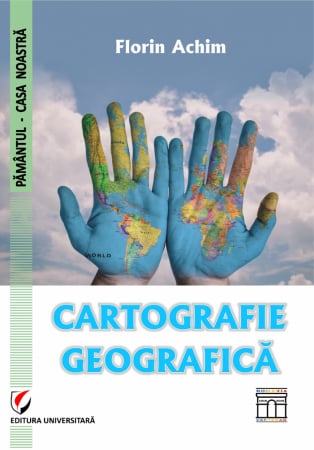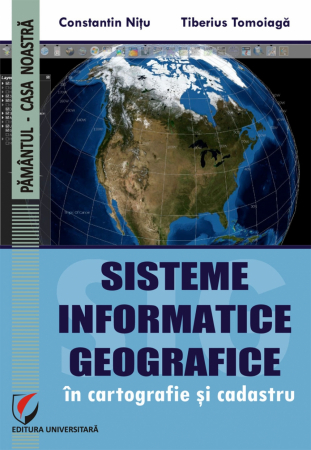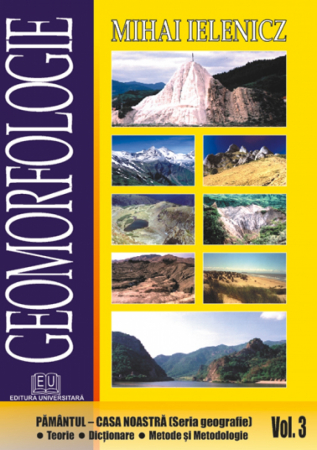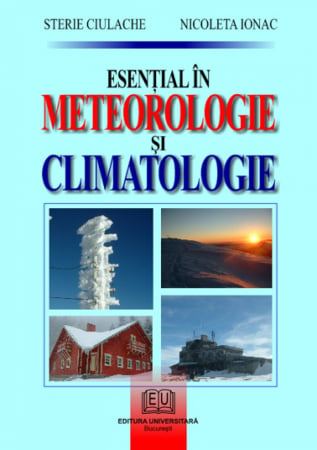Manuscript proposals: [email protected] / 0745 204 115 //// Tracking orders Individuals / Sales: 0745 200 357 / Orders Legal entities: 0721 722 783
ISBN: 978-973-749-519-8
Publisher year: 2009
Edition: I
Pages: 296
Publisher: Editura Universitară
Author: Laura Comanescu, Mihai Ielenicz
Product Code:
9789737495198
Do you need help?
0745 200 357
- Description
- Download (1)
- Authors
- Content
- More details
- Reviews (0)
This paper is absolutely necessary for geographers, students from different profiles of the Faculty of Geography and from all forms of education (day, FR, ID) that decipher some of the secrets of physical geography. It is based on the work General Geography - Physical Geography, published in the Romania of Tomorrow Foundation Publishing House in 2000, author prof.univ.dr. Mihai Ielenicz, but also many other treatises and university courses, including Simion Mehedinti's "Terra". The structure of the paper follows the most important issues that must be presented and explained in such a paper, namely: Object, History, Methods and Laws of Geography, Universe, Earth and its place in the Universe, Terrestrial Geospheres, Great natural-geographical systems. Each of the 5 major problems mentioned above are performed in accordance with the analytical program of this discipline, related to the number of hours provided in the curriculum. As a result, a logical chaining of the basic issue was considered, starting from the general to the particular.
At the end of the five sections there are some practical works from this study discipline, in which are presented the notions of geographical methodology that must be mastered, at this stage, in this course.
As a result, what is the purpose of this paper?
• to solve the essential requirements of this science: understanding the geographical system (limits, composition, structure, functionality, laws) and knowing the set of relationships that it has acquired over time with other systems;
• to ensure the theoretical understanding (basic notions, laws, methods, relations) and the knowledge of the spatial and temporal evolution of the geographical system and of the component subsystems;
• to highlight the main necessary notions about the Universe and the place of the Earth within it;
• to lead to the understanding of the functional and structural relations that exist between the terrestrial geospheres that materialize in the great natural-geographical systems;
• to select from the multitude of notions of this discipline but also of the basic courses that the students follow the most important ones that outline the connections and the interaction between the components of the geographical environment, avoiding as much as possible the overlaps.
Product compliance information
At the end of the five sections there are some practical works from this study discipline, in which are presented the notions of geographical methodology that must be mastered, at this stage, in this course.
As a result, what is the purpose of this paper?
• to solve the essential requirements of this science: understanding the geographical system (limits, composition, structure, functionality, laws) and knowing the set of relationships that it has acquired over time with other systems;
• to ensure the theoretical understanding (basic notions, laws, methods, relations) and the knowledge of the spatial and temporal evolution of the geographical system and of the component subsystems;
• to highlight the main necessary notions about the Universe and the place of the Earth within it;
• to lead to the understanding of the functional and structural relations that exist between the terrestrial geospheres that materialize in the great natural-geographical systems;
• to select from the multitude of notions of this discipline but also of the basic courses that the students follow the most important ones that outline the connections and the interaction between the components of the geographical environment, avoiding as much as possible the overlaps.
-
Geografie fizica generala cu elemente de cosmologie
Download
MIHAI IELENICZ
Prof. PhD, a graduate of Geology-Geography in 1964 where he continued going through all the academic hierarchy. PhD in Geography in 1978 with his "Mountains of Buzau basin - geomorphology study", published in the Academy in 1984.
He won an Academy Award in 1975 for his "relief Romania" and in 1985 for his "Encyclopedia of Romania" and the title of Doctor Honoris Causa of the University Stefan cel Mare - Suceava, he was awarded over 25 honorary degrees, excellent and medals of different educational and scientific institutions home and abroad. Dean and Dean of the Faculty of Geography from 1992 to present, Director of Resort Geographic Orsova, Co-director of "research center and dynamic geomorphological land degradation"
Member of Faculty Council and University Senate since 1992, Chairman of National Committee for the undergraduate education programs (since 1996), member CNATDC, CNEAA, expert CNCSIS, improvements in the country and abroad (UK, Belgium, Turkey), President of the Olympics School of Geography (1996), President of the Society of Geography (2003), Vice President of National Committee of Geography (2000), Vice President of the Association of Geomorphology (2002), PhD (1993), a member of teams The editor of numerous magazines, etc.. He wrote alone and over 210 scientific papers together, participated in 62 research contracts (18 as director), 38 scientific books: "General Geomorphology" 1976, 2002, "Romanian Relief" 1975, "the hills and plateaus of Romania "1999," Physical and Geographical Dictionary "1999," General Geography "2001," Geography and Tourism Romania "2001," Europe Geographical Encyclopedia "2002," Romania Subcarpatii "2003," Romania - Physical Geography "2004," General Physical Geography . Fundamentals of physical geography "2005" Subcarpatii Romania "2005," Geomorphology "2007, 2010," Romania. Physical Geography. Climate, water, vegetation, soils, "2007," Romania. Plateaus and hills "2008," Dictionary of geomorphology "2009," General Physical Geography elements of cosmology "2009," Romania - tourism potential "2009, and numerous popular books, maps etc.
LAURA COMANESCU
Prof. PhD, a graduate of Geology-Geography in 1964 where he continued going through all the academic hierarchy. PhD in Geography in 1978 with his "Mountains of Buzau basin - geomorphology study", published in the Academy in 1984.
He won an Academy Award in 1975 for his "relief Romania" and in 1985 for his "Encyclopedia of Romania" and the title of Doctor Honoris Causa of the University Stefan cel Mare - Suceava, he was awarded over 25 honorary degrees, excellent and medals of different educational and scientific institutions home and abroad. Dean and Dean of the Faculty of Geography from 1992 to present, Director of Resort Geographic Orsova, Co-director of "research center and dynamic geomorphological land degradation"
Member of Faculty Council and University Senate since 1992, Chairman of National Committee for the undergraduate education programs (since 1996), member CNATDC, CNEAA, expert CNCSIS, improvements in the country and abroad (UK, Belgium, Turkey), President of the Olympics School of Geography (1996), President of the Society of Geography (2003), Vice President of National Committee of Geography (2000), Vice President of the Association of Geomorphology (2002), PhD (1993), a member of teams The editor of numerous magazines, etc.. He wrote alone and over 210 scientific papers together, participated in 62 research contracts (18 as director), 38 scientific books: "General Geomorphology" 1976, 2002, "Romanian Relief" 1975, "the hills and plateaus of Romania "1999," Physical and Geographical Dictionary "1999," General Geography "2001," Geography and Tourism Romania "2001," Europe Geographical Encyclopedia "2002," Romania Subcarpatii "2003," Romania - Physical Geography "2004," General Physical Geography . Fundamentals of physical geography "2005" Subcarpatii Romania "2005," Geomorphology "2007, 2010," Romania. Physical Geography. Climate, water, vegetation, soils, "2007," Romania. Plateaus and hills "2008," Dictionary of geomorphology "2009," General Physical Geography elements of cosmology "2009," Romania - tourism potential "2009, and numerous popular books, maps etc.
LAURA COMANESCU
INTRODUCTION / 7
PART 1 - OBJECT, HISTORY, METHODS AND LAWS OF GEOGRAPHY, SYSTEMS OF GEOGRAPHICAL UNITS / 9
1. Name. Definition. The first divisions / 9
1.1. Antiquity and the Middle Ages - epochs of shaping this science / 9
1.2. Establishing the name, making a definition and the first divisions of geography / 13
1.3. 20th / 16th century
2. The object of geography - name and definition / 21
2.1. Name of the object of geography / 21
3. Geographical coverage - Global system / 27
3.1. The limits of the geographical system / 29
3.2. Composition and structure of the geographical system / 30
3.3. Characteristics of the geographical system / 30
3.4. Contact between geographic systems. Discontinuity between systems / 42
4. The place of physical geography within the global geographical system / 46
5. Study methods used in geography / 48
5.1. General methods applied in several sciences / 48
5.2. Methods used in close sciences in close sciences / 49
5.3. Geography specific methods / 50
6. The connections of geography with other sciences / 57
7. The laws of the geographical natural envelope / 58
7.1. Universal laws / 58
7.2. Global laws / 59
7.3. Specific laws / 64
8. Area, region, type, landscape / 65
8.1. Zone-Zoning / 65
8.2. Region-region / 69
8.3. Types and typing / 73
8.4. Geographical landscape - system reflection / 76
PART 2 - THE UNIVERSE / 89
1. The general picture of the universe / 89
1.1. Definitions, Limits / 89
1.2. Characteristics of the universe / 90
1.3. The composition and structures of the universe / 90
1.4. The origin and evolution of the universe / 96
2. The Milky Way (our galaxy) and the solar system / 100
2.1. Milky Way / 100
2.2. Solar system / 101
2.3. The Evolution of the Sun / 111
2.5. Small bodies in the solar system / 128
PART 3 - THE EARTH AND ITS PLACE IN THE UNIVERSE / 141
1. The earth and the global geographic system / 141
1.1. Earth shape and geographical consequences / 141
1.2. Rotational motion of the earth / 145
1.3. Revolutionary movement / 150
1.4. Physical properties of the earth / 154
2. Luna / 159
2.1. General landmarks / 159
2.2. Monthly relief / 160
2.3. Petrographic composition / 161
2.4. Structure / 161
2.5. Physical properties / 161
2.6. Origin of the Moon / 163
2.7. Stages of evolution / 163
3. Phenomena determined by the earth-moon-sun system / 165
3.1. Phases of the month / 165
3.2. Eclipses / 166
3.3. Tides / 171
PART 4. TERRESTRIAL GEOSPHERES / 181
1. Terrestrial endospheres (Endogeospheres) / 181
1.1. The internal structure of the earth / 181
1.2. Tectonosphere and the forms of movement of matter within it; Geographical consequences / 185
2. Exospheres (Exogeospheres in the geosphere shells. The outer shells of the earth) / 191
2.1. Reliosphere / 191
2.2. The water cover of the earth (Hydrosphere) / 210
2.3. Climatosphere / 218
2.4. Biosphere / 223
PART 5. THE GREAT NATURAL-GEOGRAPHICAL SYSTEMS / 235
1. Natural areas and regions on land / 235
1.1. Hot zone / 235
2. Natural areas and regions in ocean basins / 277
2.1. Domains of life / 277
2.2. Regional differences / 278
PART 6. PRACTICAL APPLICATIONS / 289
1. Elements of geographical methodology / 289
1.1. Fisa geografica / 289
1.2. Bibliography / 289
1.4. The stages of the physical-geographical study / 291
1.5. Review / 291
1.6. Poster / 291
1.7. Oral presentation / 292
1.8. Essay / 292
1.9. Monograph. Physical - geographical study of a unit / 292
BIBLIOGRAPHY / 295
PART 1 - OBJECT, HISTORY, METHODS AND LAWS OF GEOGRAPHY, SYSTEMS OF GEOGRAPHICAL UNITS / 9
1. Name. Definition. The first divisions / 9
1.1. Antiquity and the Middle Ages - epochs of shaping this science / 9
1.2. Establishing the name, making a definition and the first divisions of geography / 13
1.3. 20th / 16th century
2. The object of geography - name and definition / 21
2.1. Name of the object of geography / 21
3. Geographical coverage - Global system / 27
3.1. The limits of the geographical system / 29
3.2. Composition and structure of the geographical system / 30
3.3. Characteristics of the geographical system / 30
3.4. Contact between geographic systems. Discontinuity between systems / 42
4. The place of physical geography within the global geographical system / 46
5. Study methods used in geography / 48
5.1. General methods applied in several sciences / 48
5.2. Methods used in close sciences in close sciences / 49
5.3. Geography specific methods / 50
6. The connections of geography with other sciences / 57
7. The laws of the geographical natural envelope / 58
7.1. Universal laws / 58
7.2. Global laws / 59
7.3. Specific laws / 64
8. Area, region, type, landscape / 65
8.1. Zone-Zoning / 65
8.2. Region-region / 69
8.3. Types and typing / 73
8.4. Geographical landscape - system reflection / 76
PART 2 - THE UNIVERSE / 89
1. The general picture of the universe / 89
1.1. Definitions, Limits / 89
1.2. Characteristics of the universe / 90
1.3. The composition and structures of the universe / 90
1.4. The origin and evolution of the universe / 96
2. The Milky Way (our galaxy) and the solar system / 100
2.1. Milky Way / 100
2.2. Solar system / 101
2.3. The Evolution of the Sun / 111
2.5. Small bodies in the solar system / 128
PART 3 - THE EARTH AND ITS PLACE IN THE UNIVERSE / 141
1. The earth and the global geographic system / 141
1.1. Earth shape and geographical consequences / 141
1.2. Rotational motion of the earth / 145
1.3. Revolutionary movement / 150
1.4. Physical properties of the earth / 154
2. Luna / 159
2.1. General landmarks / 159
2.2. Monthly relief / 160
2.3. Petrographic composition / 161
2.4. Structure / 161
2.5. Physical properties / 161
2.6. Origin of the Moon / 163
2.7. Stages of evolution / 163
3. Phenomena determined by the earth-moon-sun system / 165
3.1. Phases of the month / 165
3.2. Eclipses / 166
3.3. Tides / 171
PART 4. TERRESTRIAL GEOSPHERES / 181
1. Terrestrial endospheres (Endogeospheres) / 181
1.1. The internal structure of the earth / 181
1.2. Tectonosphere and the forms of movement of matter within it; Geographical consequences / 185
2. Exospheres (Exogeospheres in the geosphere shells. The outer shells of the earth) / 191
2.1. Reliosphere / 191
2.2. The water cover of the earth (Hydrosphere) / 210
2.3. Climatosphere / 218
2.4. Biosphere / 223
PART 5. THE GREAT NATURAL-GEOGRAPHICAL SYSTEMS / 235
1. Natural areas and regions on land / 235
1.1. Hot zone / 235
2. Natural areas and regions in ocean basins / 277
2.1. Domains of life / 277
2.2. Regional differences / 278
PART 6. PRACTICAL APPLICATIONS / 289
1. Elements of geographical methodology / 289
1.1. Fisa geografica / 289
1.2. Bibliography / 289
1.4. The stages of the physical-geographical study / 291
1.5. Review / 291
1.6. Poster / 291
1.7. Oral presentation / 292
1.8. Essay / 292
1.9. Monograph. Physical - geographical study of a unit / 292
BIBLIOGRAPHY / 295
This paper is absolutely necessary for geographers, students from different profiles of the Faculty of Geography and from all forms of education (day, FR, ID) that decipher some of the secrets of physical geography. It is based on the work General Geography - Physical Geography, published in the Romania of Tomorrow Foundation Publishing House in 2000, author prof.univ.dr. Mihai Ielenicz, but also many other treatises and university courses, including Simion Mehedinti's "Terra". The structure of the paper follows the most important issues that must be presented and explained in such a paper, namely: Object, History, Methods and Laws of Geography, Universe, Earth and its place in the Universe, Terrestrial Geospheres, Great natural-geographical systems. Each of the 5 major problems mentioned above are performed in accordance with the analytical program of this discipline, related to the number of hours provided in the curriculum. As a result, a logical chaining of the basic issue was considered, starting from the general to the particular.
At the end of the five sections there are some practical works from this study discipline, in which are presented the notions of geographical methodology that must be mastered, at this stage, in this course.
As a result, what is the purpose of this paper?
• to solve the essential requirements of this science: understanding the geographical system (limits, composition, structure, functionality, laws) and knowing the set of relationships that it has acquired over time with other systems;
• to ensure the theoretical understanding (basic notions, laws, methods, relations) and the knowledge of the spatial and temporal evolution of the geographical system and of the component subsystems;
• to highlight the main necessary notions about the Universe and the place of the Earth within it;
• to lead to the understanding of the functional and structural relations that exist between the terrestrial geospheres that materialize in the great natural-geographical systems;
• to select from the multitude of notions of this discipline but also of the basic courses that the students follow the most important ones that outline the connections and the interaction between the components of the geographical environment, avoiding as much as possible the overlaps.
Starting from the previous experience of the authors, each study module has a didactic structure, being formulated the objectives to be achieved after reading the material, being presented exercises, verification questions, dictionary of terms and finally a basic bibliography.
The dictionary of geographical terms aims to explain the most important and usual notions that must be mastered, the realization of a geographical vocabulary being one of the primary desideratum of a general geography course.
The questions at the end of each module cover the most important aspects, are different as types of items and aim to achieve permanent self-assessment out of the desire for the student to know permanently where he is on the training ladder.
I tried that this paper be accompanied by a carefully chosen illustrative material that is explanatory, convinced of its power of suggestion and its importance in geographical demonstrations.
The final goal of our paper is on the one hand to be a useful tool for first year students from all forms of education, to master the most important and complex notions of physical geography, of the natural geographical envelope in its structural unity. and functional, and on the other hand to acquire a logical way of thinking that can help him in analyzes and formulations.
That is why we want this book to be for the geography students like an Alphabet, because the Alphabet remains well imprinted in our minds all our lives.
The Authors
At the end of the five sections there are some practical works from this study discipline, in which are presented the notions of geographical methodology that must be mastered, at this stage, in this course.
As a result, what is the purpose of this paper?
• to solve the essential requirements of this science: understanding the geographical system (limits, composition, structure, functionality, laws) and knowing the set of relationships that it has acquired over time with other systems;
• to ensure the theoretical understanding (basic notions, laws, methods, relations) and the knowledge of the spatial and temporal evolution of the geographical system and of the component subsystems;
• to highlight the main necessary notions about the Universe and the place of the Earth within it;
• to lead to the understanding of the functional and structural relations that exist between the terrestrial geospheres that materialize in the great natural-geographical systems;
• to select from the multitude of notions of this discipline but also of the basic courses that the students follow the most important ones that outline the connections and the interaction between the components of the geographical environment, avoiding as much as possible the overlaps.
Starting from the previous experience of the authors, each study module has a didactic structure, being formulated the objectives to be achieved after reading the material, being presented exercises, verification questions, dictionary of terms and finally a basic bibliography.
The dictionary of geographical terms aims to explain the most important and usual notions that must be mastered, the realization of a geographical vocabulary being one of the primary desideratum of a general geography course.
The questions at the end of each module cover the most important aspects, are different as types of items and aim to achieve permanent self-assessment out of the desire for the student to know permanently where he is on the training ladder.
I tried that this paper be accompanied by a carefully chosen illustrative material that is explanatory, convinced of its power of suggestion and its importance in geographical demonstrations.
The final goal of our paper is on the one hand to be a useful tool for first year students from all forms of education, to master the most important and complex notions of physical geography, of the natural geographical envelope in its structural unity. and functional, and on the other hand to acquire a logical way of thinking that can help him in analyzes and formulations.
That is why we want this book to be for the geography students like an Alphabet, because the Alphabet remains well imprinted in our minds all our lives.
The Authors
If you want to express your opinion about this product you can add a review.
write a review

6359.png)
![General Physical Geography with Elements of Cosmology [1] General Physical Geography with Elements of Cosmology [1]](https://gomagcdn.ro/domains/editurauniversitara.ro/files/product/large/general-physical-geography-with-elements-of-cosmology-2673-7598.jpg)














